Formulae Handbook for Class 10 Maths and Science
Lakhmir Singh Physics Class 10 Solutions Electricity
Lakhmir Singh Physics Class 10 Solutions Page No:5
Question 1:
By what other name is the unit joule/coulomb called ?
Solution :
Volt
Question 2:
Which of the following statements correctly defines a volt ?
(a) a volt is a joule per ampere.
(b) a volt is a joule per coulomb.
Solution :
(b) a volt is a joule per coulomb.
Question 3:
(a) What do the letters p.d. stand for ?
(b) Which device is used to measure p.d. ?
Solution :
(a) p.d. stands for potential difference.
(b) Voltmeter is used to measure p.d.
Did you check the Prevous Year Questions of Class 10 Electricity ?
Question 4:
What is meant by saying that the electric potential at a point is 1 volt ?
Solution :
Electric potential at a point is 1 volt means 1 joule of work is done in moving 1 unit positive charge from infinity to that point.
Question 5:
How much work is done when one coulomb charge moves against a potential difference of 1 volt ?
Solution :
Potential difference = 1 V
Charge moved = 1C
Work done = Potential difference x Charge moved
= 1 x 1 = 1 J
Question 6:
What is the SI unit of potential difference ?
Solution :
Volt
Question 7:
How much work is done in moving a charge of 2 C across two points having a potential difference of 12 V ?
Solution :
Given,
Potential difference = 12 V,Charge moved = 2 C
We know that,
Work done= p.d. x charge moved
= 12 x 2
= 24 joules.
Question 8:
What is the unit of electric charge ?
Solution :
Coulomb
Question 9:
Define one coulomb charge.
Solution :
One coulomb of charge is that quantity of charge which exerts a force of 9 × 109 Newton on an equal charge is placed at a distance of 1 m from it.
Question 10:
Fill in the following blanks with suitable words :
(a) Potential difference is measured in………….. by using a……………. placed in………… across a component.
(b) Copper is a good………….. Plastic is an……………
Solution :
(a) volts; voltmeter; parallel
(b) conductor; insulator
Question 11:
What is meant by conductors and insulators ? Give two examples of conductors and two of insulators.
Solution :
Conductors:- Those substances through which electricity can flow are known as conductors. E.g., Copper, silver etc.
Insulators:- Those substances through which electricity cannot flow are known as insulators. E.g., Plastic, cotton etc.
Question 12:
Which of the following are conductors and which are insulators ?
Sulphur, Silver, Copper, Cotton, Aluminium, Air, Nichrome, Graphite, Paper, Porcelain, Mercury, Mica, Bakelite, Polythene, Manganin.
Solution :
Conductor:- Silver, Copper, Aluminum, Nichrome, Graphite, Mercury, Manganin
Insulators:- Sulphur, Cotton, Air, Paper, Porcelain, Mica, Bakelite, Polythene
Question 13:
What do you understand by the term “electric potential” ? (or potential) at a point ? What is the unit of electric potential ?
Solution :
The electric potential (or potential) at a point in an electric field is defined as the work done in moving a unit positive charge from infinity to that point.
Unit of electric potential is volt.
Question 14:
(a) State the relation between potential difference, work done and charge moved.
(b) Calculate the work done in moving a charge of 4 coulombs from a point at 220 volts to another point at 230 volts.
Solution :
(a) Potential difference = Work done/Charge moved.
(b) V1=220 V, V2=230V, Charge moved=4C
Thus, the potential difference= V2- V1 =230-220
=10.
We know that,
Work done = Potential difference x Charge moved
= 10 x 4
Work done = 40 joules
Question 15:
(a) Name a device that helps to measure the potential difference across a conductor.
(b) How much energy is transferred by a 12 V power supply to each coulomb of charge which it moves around a circuit ?
Solution :
(a) Voltmeter
(b) Given : Potential difference=12V, Charge moved=1C
We know that,
Work done = Potential difference x charge moved
= 12 x 1 = 12 joules
Since work done on each coulomb of charge is 12 joules, the energy given to each coulomb of charge is also 12 joules.
Lakhmir Singh Physics Class 10 Solutions Page No:6
Question 16:
(a) What do you understand by the term “potential difference” ?
(b) What is meant by saying that the potential difference between two points is 1 volt ?
(c) What is the potential difference between the terminals of a battery if 250 joules of work is required to transfer 20 coulombs of charge from one terminal of battery to the other ?
(d) What is a voltmeter ? How is a voltmeter connected in the circuit to measure the potential difference between two points. Explain with the help of a diagram.
(e) State whether a voltmeter has a high resistance or a low resistance. Give reason for your answer.
Solution :
(a) Potential difference between two points in an electric circuit is defined as the amount of work done in moving a unit charge from one
point to the other point.
(b) The potential difference between two points is 1 volt means 1 joule of work is done in moving 1 coulomb of electric charge from one point to the other.
(c) Given: Work done = 250J, Charge moved = 20C.
we know that,Potential difference = Work done/Charge moved
=250/20=12.5
(d) A voltmeter is a device which is used to measure the potential difference between two points in an electric circuit. Voltmeter is always connected in parallel across the two points where the potential difference is to be measured.
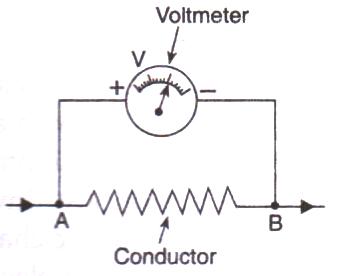
(e) Voltmeter has a high resistance so that it takes a negligible current from the circuit.
Question 22:
Three 2 V cells are connected in series and used as a battery in a circuit.
(a) What is the p.d. at the terminals of the battery ?
(b) How many joules of electrical energy does 1 C gain on passing through (i) one cell (ii) all three cells ?
Solution :
(a) If three cells of 2 volt each are connected in series to make a battery, then the total potential difference between terminals of the battery will be 6V.
(b) (i) Given: p.d. = 2V, Charge moved = 1C
We know that
Work done = p.d. x charge moved
= 2 x 1
Work done = 2 joules
(ii) Given: p.d. = 6V, Charge moved = 1C
Work done = p.d. x charge moved
= 6 x1
Work done = 6 joule.
Question 23:
The atoms of copper contain electrons and the atoms of rubber also contain electrons. Then why does copper conduct electricity but rubber does not conduct electricity ?
Solution :
Copper has free electrons that are loosely held by the nuclei of the atoms. These free electrons result in conduction of electricity.
The electrons present in rubber are strongly held by the nuclei of its atoms. So, rubber does not have free electrons to conduct electricity.
Lakhmir Singh Physics Class 10 Solutions Page No:11
Question 1:
By what name is the physical quantity coulomb/second called ?
Solution :
Ampere
Question 2:
What is the flow of charge called ?
Solution :
Electric Current.
Question 3:
What actually travels through the wires when you switch on a light ?
Solution :
Electrons.
Question 4:
Which particles constitute the electric current in a metallic conductor ?
Solution :
Electrons.
Question 5:
(a) In which direction does conventional current flow around a circuit ?
(b) In which direction do electrons flow ?
Solution :
(a) Conventional current flows from positive terminal of a battery to the negative terminal, through the outer circuit.
(b) Electrons flow from negative terminal to positive terminal of the battery (opposite to the direction of conventional current).
Question 6:
Which of the following equation shows the correct relationship between electrical units ?
1 A = 1 C/s or 1 C = 1 A/s
Solution :
1A = 1C/s
Question 7:
What is the unit of electric current ?
Solution :
Ampere.
Question 8:
(a) How many milliamperes are there in 1 ampere ?
(b) How many microamperes are there in 1 ampere ?
Solution :
(a) 1 amp = 10
3
milli amp.
(b) 1 amp = 10
6
micro amp.
Question 9:
Which of the two is connected in series : ammeter or voltmeter ?
Solution :
Ammeter is connected in series.
Question 10:
Compare how an ammeter and a voltmeter are connected in a circuit.
Solution :
Ammeter is connected in series in a circuit whereas voltmeter is connected in parallel.
Question 11:
What do the following symbols mean in circuit diagrams ?

Solution :
(i) Variable resistance.
(ii) A closed plug key.
Question 12:
If 20 C of charge pass a point in a circuit in 1 s, what current is flowing ?
Solution :
Given, Q = 20 C, t=1s
I=?
We know that:
I=Q/t.
I=20/1=20A.
Question 13:
A current of 4 A flows around a circuit for 10 s. How much charge flows past a point in the circuit in this time ?
Solution :
Given, I=4amp, C, t=10s Q=?
We know that:
I=Q/t.
Q=4*10=40C.
Question 14:
What is the current in a circuit if the charge passing each point is 20 C in 40 s ?
Solution :
Given, Q = 20 C, t=1s
I=?
We know that:
I=Q/t.
Thus I=20/40=0.5A.
Question 15:
Fill in the following blanks with suitable words :
(a) A current is a flow of……….. For this to happen there must be a………….
(b) Current is measured in……… using an………… placed in……… in a circuit.
Solution :
(a) electrons; closed
(b) amperes; ammeter; series.
Question 16:
(a) Name a device which helps to maintain potential difference across a conductor (say, a bulb).
If a potential difference of 10 V causes a current of 2 A to flow for 1 minute, how much energy is
transferred ?
Solution :
(a) Cell or battery helps to maintain potential difference across a conductor.
(b) Given: p.d. = 10 V, I = 2amp, t = 1 min = 60s.
We know that:
I=Q/t.
Thus, Q=Ixt.
Q=2×60.
Q=120 C.
Work done = p.d. x charge moved
Work done = 120x10J
Work done = 1200J.
Question 17:
(a) What is an electric current ? What makes an electric current flow in a wire ?
(b) Define the unit of electric current (or Define ampere).
Solution :
(a) An electric currrent is a flow of electric charges (electrons) through a conductor.
Potential difference between the ends of the wire makes electric current to flow in the wire.
(b) When 1 coulomb of charge flows through any cross-section of a conductor in 1 second, the electric current flowing through it is said to be 1 ampere.
Question 18:
What is an ammeter ? How is it connected in a circuit ? Draw a diagram to illustrate your answer.
Solution :
Ammeter is a device used for the measurement of electric current. It is always connected in series with the circuit in which the current is to be measured.
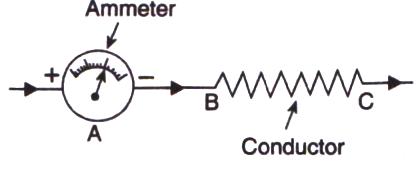
Question 19:
(a) Write down the formula which relates electric charge, time and electric current.
(b) A radio set draws a current of 0.36 A for 15 minutes. Calculate the amount of electric charge that flows through the circuit.
Solution :
(a). Work done = Potential difference x charge moved.
(b). I=0.36A, t=15min =900seconds.
Q=Ixt
=0.36×900
=324C.
Question 20:
Why should the resistance of :
(a) an ammeter be very small ?
(b) a voltmeter be very large ?
Solution :
(a) The resistance of an ammeter should be very small so that it may not change the value of the current flowing in the circuit.
(b) The resistance of a voltmeter should be very large so that it takes a negligible current from the current.
Question 21:
Draw circuit symbols for (a) fixed resistance (b) variable resistance (c) a cell (d) a battery of three cells (e) an open switch (f) a closed switch.
Solution :
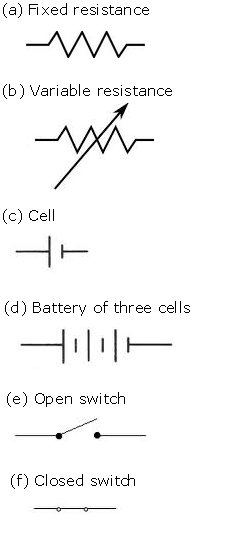
Question 22:
What is a circuit diagram ? Draw the labelled diagram of an electric circuit comprising of a cell, a resistor, an ammeter, a voltmeter and a closed switch (or closed plug key). Which of the two has a large resistance : an ammeter or a voltmeter ?
Solution :
A diagram which indicates how different components in a circuit have been connected by using the electrical symbols for the components is called a circuit diagram.
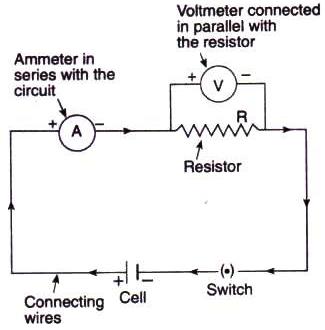
A voltmeter has a large resistance.
Question 23:
If the charge on an electron is 1.6 x 10
-19
coulombs, how many electrons should pass through a conductor in 1 second to constitute 1 ampere current ?
Solution :
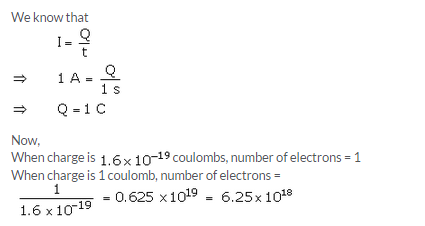
Question 24:
The p.d. across a lamp is 12 V. How many joules of electrical energy are changed into heat and light when :
(a) a charge of 1 C passes through it ?
(b) a charge of 5 C passes through it ?
(c) a current of 2 A flows through it for 10 s ?
Solution :
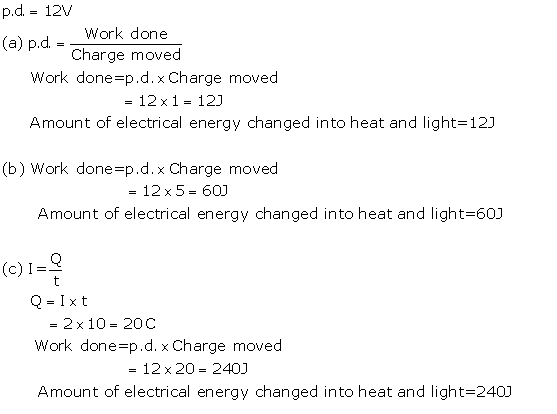
Lakhmir Singh Physics Class 10 Solutions
Page No:12
Question 25:
In 10 s, a charge of 25 C leaves a battery, and 200 j of energy are delivered to an outside circuit as a result.
(a) What is the p.d. across the battery ?
(b) What current flows from the battery ?
Solution :

Question 26:
(a) Define electric current. What is the SI unit of electric current.
(b) One coulomb of charge flows through any cross-section of a conductor in 1 second. What is the current flowing through the conductor ?
(c) Which instrument is used to measure electric current ? How should it be connected in a circuit ?
(d) What is the conventional direction of the flow of electric current ? How does it differ from the direction of flow of electrons ?
(e) A flash of lightning carries 10 C of charge which flows for 0.01 s. What is the current ? If the voltage is 10 MV, what is the energy ?
Solution :
(a) Electric current is the flow of electric charges (electrons) in a conductor such as a metal wire.
SI unit of electric current is ampere.
(b) 1 ampere.
(c) An ammeter is used to measure electric current. It should be connected in series with the circuit.
(d) Conventional direction of flow of electric current is from positive terminal of a battery to the negative terminal, through the outer circuit. The direction of flow of electrons is opposite to the direction of conventional current, i.e. from negative terminal to positive terminal.
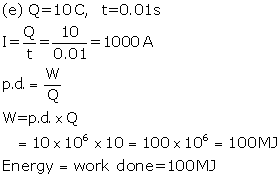
Question 32:
A student made an electric circuit shown here to measure the current through two lamps.
(a) Are the lamps in series or parallel ?
(b) The student has made a mistake in this circuit.
What is the mistake ?
(c) Draw a circuit diagram to show the correct way to connect the circuit.
Use the proper circuit symbols in your diagram.

Solution :
(a) Lamps are in series.
(b) Student has connected ammeter in parallel with lamps. It should be connected in series.
(c)
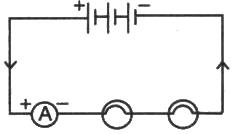
Question 33:
Draw a circuit diagram to show how 3 bulbs can be lit from a battery so that 2 bulbs are controlled by the same switch while the third bulb has its own switch.
Solution :
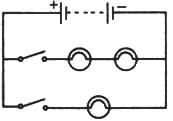
Question 34:
An electric heater is connected to the 230 V mains supply. A current of 8 A flows through the heater.
(a) How much charge flows around the circuit each second ?
(b) How much energy is transferred to the heater each second ?
Solution :
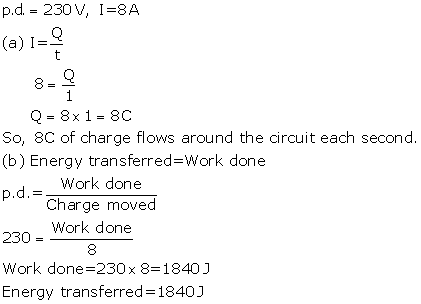
Question 35:
How many electrons are flowing per second past a point in a circuit in which there is a current of 5 amp ?
Solution :
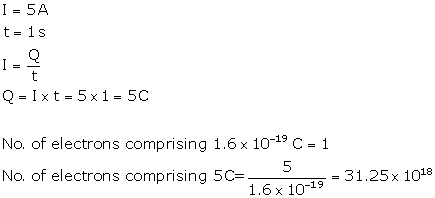
Lakhmir Singh Physics Class 10 Solutions Page No:18
Question 1:
Name the law which relates the current in a conductor to the potential difference across its ends.
Solution :
Ohm’s law
Question 2:
Name the unit of electrical resistance and give its symbol.
Solution :

Question 3:
Name the physical quantity whose unit is “ohm”.
Solution :
Electric resistance.
Question 4:
What is the general name of the substances having infinitely high electrical resistance ?
Solution :
Insulators.
Question 5:
Keeping the resistance constant, the potential difference applied across the ends of a component is halved. By how much does the current change ?
Solution :

Question 6:
State the factors on which the strength of electric current flowing in a given conductor depends.
Solution :
Strength of electric current flowing in a given conductor depends on
(i) potential difference across the ends of the conductor
(ii) resistance of the conductor.
Question 7:
Which has less electrical resistance : a thin wire or a thick wire (of the same length and same material) ?
Solution :
Thick wire.
Question 8:
Keeping the potential difference constant, the resistance of a circuit is halved. By how much does the current change ?
Solution :
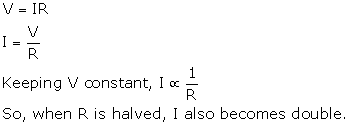
Question 9:
A potential difference of 20 volts is applied across the ends of a resistance of 5 ohms. What current will flow in the resistance ?
Solution :
Potential difference, V = 20V
Resistance, R = 5ohms
Current, I = ?
We know that
V=IR
20 = I x 5
I = 20/5 = 4 A
Question 10:
A resistance of 20 ohms has a current of 2 amperes flowing in it. What potential difference is there between its ends ?
Solution :
R = 20ohms
I = 2amp
We know that
V = IR
Thus,
V = 2 x 20
V = 40V
Question 11:
A current of 5 amperes flows through a wire whose ends are at a potential difference of 3 volts. Calculate the resistance of the wire.
Solution :
I = 5amp
p.d., V = 3V
We know that
V=IR
Thus,
3 = 5 x R
R = 3/5 = 0.6 ohm
Question 12:
Fill in the following blank with a suitable word :
Ohm’s law states a relation between potential difference and……………………
Solution :
current.
Question 13:
Distinguish between good conductors, resistors and insulators. Name two good conductors, two resistors and two insulators.
Solution :
Those substances which have very low electrical resistance are called as good conductors. E.g., copper and aluminium.
Those substances which have comparatively high resistance than conductors are known as resistors. E.g., nichrome and manganin.
Those substances which have infinitely high electrical resistance are called insulators. E.g., rubber and wood.
Question 14:
Classify the following into good conductors, resistors and insulators :
Rubber, Mercury, Nichrome, Polythene, Aluminium, Wood, Manganin, Bakelite, Iron, Paper, Thermocol, Metal coin
Solution :
Conductor :- mercury, aluminum, iron, metal coin
Resistor :- manganin, nichrome
Insulator :- rubber, polythene, wood, bakelite, paper, thermocol
Lakhmir Singh Physics Class 10 Solutions Page No:19
Question 15:
What is Ohm’s law ? Explain how it is used to define the unit of resistance.
Solution :
Ohm’s law gives a relationship between current (I) and potential difference (V). According to ohm’s law: At constant temperature, the current flowing through a conductor is directly proportional to the potential difference across its ends.
If I is the current flowing through a conductor and V is the p.d. across its ends, then according to the ohm’s law:
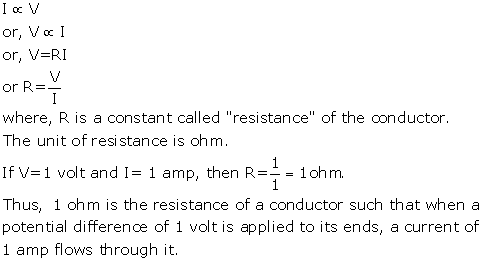
Question 16:
(a) What is meant by the “resistance of a conductor” ? Write the relation between resistance, potential
difference and current.
(b) When a 12 V battery is connected across an unknown resistor, there is a current of 2.5 mA in the circuit. Calculate the value of the resistance of the resistor.
Solution :
(a) The property of a conductor due to which it opposes the flow of current through it is called resistance of the conductor.
Work done = Potential difference x charge moved.
(b) V = 12volt, I=2.5 x 10-3 A
We know that
V=IR
R=V/I
R=12/(2.5X10-3)
R=4.8X103ohm = 4800 ohm.
Question 17:
(a) Define the unit of resistance (or Define the unit “ohm”).
What happens to the resistance as the conductor is made thinner ?
Keeping the potential difference constant, the resistance of a circuit is doubled. By how much does the current change ?
Solution :
(a) 1 ohm is the resistance of a conductor such that when a potential difference of 1 volt is applied to its ends, a current of 1ampere flows through it.
(b) Its resistance will increase.
(c)
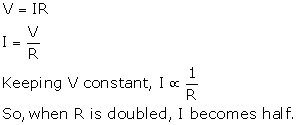
Question 18:
(a) Why do electricians wear rubber hand gloves while working with electricity ?
(b) What p.d. is needed to send a current of 6 A through an electrical appliance having a resistance of 40 Ω ?
Solution :
(a) Electricians wear rubber hand gloves while working with electricity because rubber is an insulator and protects them from electric shocks.
(b) I=6amp, R=40ohm
We know that
V=IR
V = 6 x 40 = 240 V.
Question 19:
An electric circuit consisting of a 0.5 m long nichrome wire XY, an ammeter, a voltmeter, four cells of 1.5 V each and a plug key was set up.
(i) Draw a diagram of this electric circuit to study the relation between the potential difference maintained between the points ‘X’ and ‘Y’ and the electric current flowing through XY.
(ii) Following graph was plotted between V and I values :

What would be the values of \(\frac{1}{V}\) ratios when the potential difference is 0.8 V, 1.2 V and 1.6 V respectively ? What conclusion do you draw from these values ?
(iii) What is the resistance of the wire ?
Solution :
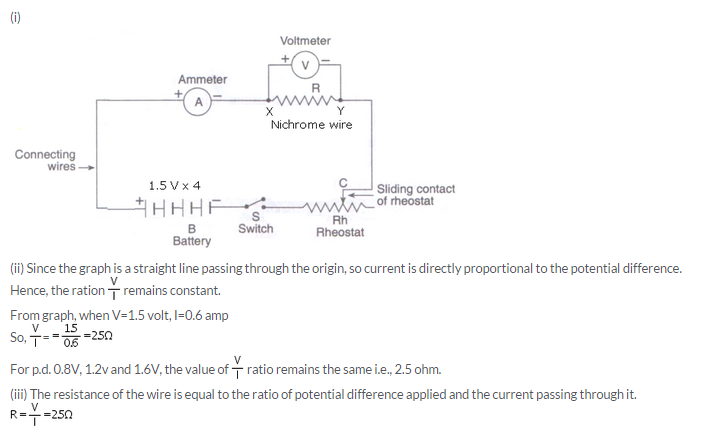
Question 20:
(a) What is the ratio of potential difference and current known as ?
(b) The values of potential difference V applied across a resistor and the corresponding values of current I
flowing in the resistor are given below :

(c) Name the law which is illustrated by the above V-I graph.
(d) Write down the formula which states the relation between potential difference, current and resistance,
(e) The potential difference between the terminals of an electric iron is 240 V and the current is 5.0 A. What is the resistance of the electric iron ?
Solution :
(a) The ratio of potential difference and current is known as resistance.
(c) Ohm’s law
(d) Potential difference = Current x Resistane
(e) V = 240 volt, I = 5amp
We know that
V=IR
240 = 5 x R
R = 240/5 = 48 ohm.
PAGE 30:
Question 30:
An electric room heater draws a current of 2.4 A from the 120 V supply line. What current will this room heater draw when connected to 240 V supply line ?
Solution :
In first case,
I = 2.4 amp, V = 120 volt
V=IR
120 = 2.4 x R
R = 120/2.4 = 50 ohm
In second case,
V = 240 volt, R = 50 ohm
V = IR
240 = I x 50
I =4.8 amp.
Question 31:
Name the electrical property of a material whose symbol is “omega”.
Solution :
Resistance.
Question 32:
The graph between V and 1 for a conductor is a straight line passing through the origin.
Which law is illustrated by such a graph ?
What should remain constant in a statement of this law ?
Solution :
(a) Ohm’s law
(b) Temperature.
Question 33:
A p.d. of 10 V is needed to make a current of 0.02 A flow through a wire. What p.d. is needed to make a current of 250 mA flow through the same wire ?
Solution :
In first case,
I = 0.02 amp, V = 10 volt
V=IR
10 = 0.02 x R
R = 10/0.02 = 500 ohm
In second case,
I = 250 x 10-3 amp, R = 500 ohm
V = IR
V = 250 x 10-3 x 500
V = 125 volt.
Question 34:
A current of 200 mA flows through a 4 kΩ resistor. What is the p.d. across the resistor ?
Solution :
I = 200mA = 0.2 A
R = 4 x 103ohm = 4000 ohm
We know that
V=IR
V = 0.2 x 4000
V = 800 volt.
Lakhmir Singh Physics Class 10 Solutions Page No:26
Question 1:
What happens to the resistance as the conductor is made thicker ?
Solution :
The resistance decreases.
Question 2:
If the length of a wire is doubled by taking more of wire, what happens to its resistance ?
Solution :
Resistance also gets doubled.
Question 3:
On what factors does the resistance of a conductor depend ?
Solution :
Resistance of a conductor depends on the following factors:-
Length of the conductor, area of cross section of the conductor, nature of material of the conductor and temperature of the conductor.
Question 4:
Name the material which is the best conductor of electricity.
Solution :
Silver metal.
Question 5:
Which among iron and mercury is a better conductor of electricity ?
Solution :
Iron.
Question 6:
Why are copper and aluminium wires usually used for electricity transmission ?
Solution :
Because copper and aluminium have very low resistivities.
Question 7:
Name the material which is used for making the heating element of an electric iron.
Solution :
Nichrome.
Question 8:
What is nichrome ? State its one use.
Solution :
Nichrome is an alloy of nickel, chromium, manganese ad iron having a resistivity of about 60 times more than that of copper. It is used for making the heating elements of electrical heating appliances.
Question 9:
Give two reasons why nichrome alloy is used for making the heating elements of electrical appliances.
Solution :
Nichrome alloy is used for making the heating elements of electrical appliances because:
(i) nichrome has very high resistivity
(ii) nichrome does not undergo oxidation (or burn) easily even at high temperature.
Question 10:
Why are the coils of electric irons and electric toasters made of an alloy rather than a pure metal ?
Solution :
Because
(i) resistivity of an alloy is much higher than that of a pure metal
(ii) an alloy does not undergo oxidation (or burn) easily even at high temperature.
Question 11:
Which has more resistance :
(a) a long piece of nichrome wire or a short one ?
(b) a thick piece of nichrome wire or a thin piece ?
Solution :
(a) A long piece of nichrome wire.
(b) A thin piece of nichrome wire.
Question 12:
(a) How does the resistance of a pure metal change if its temperature decreases ?
(b) How does the presence of impurities in a metal affect its resistance ?
Solution :
(a) On decreasing the temperature, the resistance decreases.
(b) Presence of impurities in a metal increases the resistance.
Question 13:
Fill in the following blanks with suitable words :
Resistance is measured in…………….. The resistance of a wire increases as the length…………………. ; as the
temperature………. ; and as the cross-sectional area…………
Solution :
Ohms; increases; increases; decreases.
Question 14:
(a) What do you understand by the “resistivity” of a substance ?
A wire is 1.0 m long, 0.2 mm in diameter and has a resistance of 10 Ω. Calculate the resistivity of its material ?
Solution :
(a) Resistivity is the characteristic property of a substance which depends on the nature of the substance and its temperature. It is numerically equal to the resistance between the opposite faces of a 1 m cube of the substance.
(b) l = 1m
r = d/2 = 0.2/2 mm = 0.1 mm = 0.0001m,
R = 10 ohm
We know that,
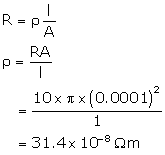
Question 15:
(a) Write down an expression for the resistance of a metallic wire in terms of the resistivity.
What will be the resistance of a metal wire of length 2 metres and area of cross-section 1.55 × 10
-6
m
2
, if the resistivity of the metal be 2.8 × 10
-8
Ωm ?
Solution :
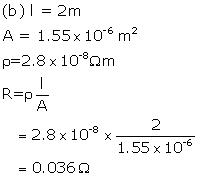
Question 16:
(a) Give two examples of substances which are good conductors of electricity. Why do you think they are
good conductors of electricity ?
Calculate the resistance of a copper wire 1.0 km long and 0.50 mm diameter if the resistivity of copper is 1.7 × 10
-8
Ωm.
Solution :
(a) Silver and copper are good conductors of electricity because they have free electrons available for conduction.
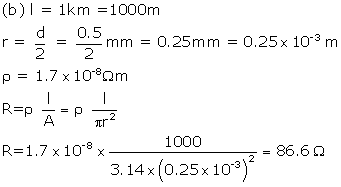
Question 17:
Will current flow more easily through a thick wire or a thin wire of the same material when connected to the same source ? Give reason for your answer.
Solution :
Current will flow more easily through thick wire because the resistance of the thick wire will be lesser than that of thin wire.
Question 18:
How does the resistance of a conductor depend on :
(a) length of the conductor ?
(b) area of cross-section of the conductor ?
(c) temperature of the conductor ?
Solution :
(a) Resistance of a conductor increases (or decreases) with increase (or decrease) in the length of the conductor.
(b) Resistance of a conductor decreases (increases) with increase (decrease) in the area of cross-section of the conductor.
(c) Resistance of a conductor increases on raising the temperature and decreases on lowering the temperature.
Question 19:
(a) Give one example to show how the resistance depends on the nature of material of the conductor.
(b) Calculate the resistance of an aluminium cable of length 10 km and diameter 2.0 mm if the resistivity of aluminium is 2.7 x 10
-8
Ωm.
Solution :
(a) If we take two similar wires of same length and same diameter, one of copper metal and other of nichrome alloy, we will find that the resistance of nichrome wire is about 60 times more than that of the copper wire. This shows that the resistance depends on the nature of material of the conductor.
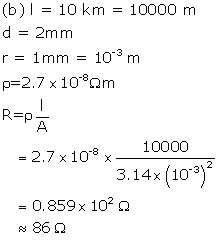
Question 20:
What would be the effect on the resistance of a metal wire of :
(a) increasing its length ?
(b) increasing its diameter ?
(c) increasing its temperature ?
Solution :
(a) Resistance will increase.
(b) Resistance will decrease.
(c) Resistance will increase.
Question 21:
How does the resistance of a wire vary with its :
(a) area of cross-section ?
(b) diameter ?
Solution :
(a) By increasing the area of cross section, the resistance will decrease.
(b) By increasing the diameter, the resistance will decrease.
Lakhmir Singh Physics Class 10 Solutions Page No:27
Question 22:
How does the resistance of a wire change when :
(i) its length is tripled ?
(ii) its diameter is tripled ?
(in) its material is changed to one whose resistivity is three times ?
Solution :
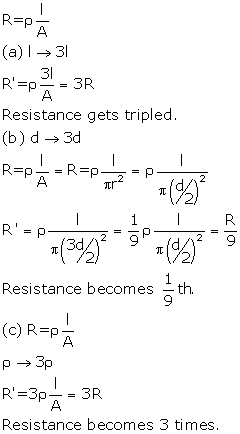
Question 23:
Calculate the area of cross-section of a wire if its length is 1.0 m, its resistance is 23 Ω and the resistivity of the material of the wire is 1.84 x 10
-6
Ωm.
Solution :
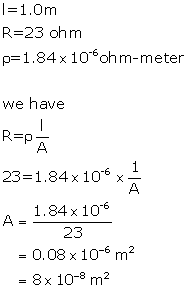
Question 24:
(a) Define resistivity. Write an expression for the resistivity of a substance. Give the meaning of each symbol
which occurs in it.
(b) State the SI unit of resistivity.
(c) Distinguish between resistance and resistivity.
(d) Name two factors on which the resistivity of a substance depends and two factors on which it does not depend.
(e) The resistance of a metal wire of length 1 m is 26 Ω at 20°C. If the diameter of the wire is 0.3 mm, what will be the resistivity of the metal at that temperature ?
Solution :
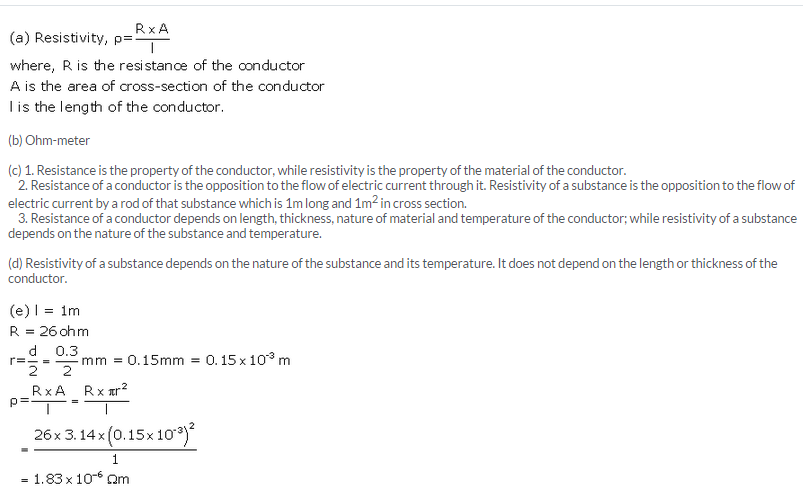
Question 33:
A piece of wire of resistance 20 Ω is drawn out so that its length is increased to twice its original length. Calculate the resistance of the wire in the new situation.
Solution :
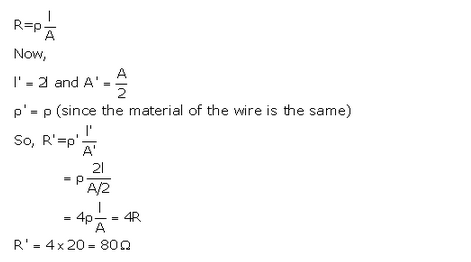
Question 34:
The electrical resistivities of three materials P, Q and R are given below :

Which material will you use for making (a) electric wires (b) handle for soldering iron, and (c) solar cells ? Give reasons for your choices.
Solution :
(a) Material Q with resistivity 2.63 X 10-8 ohm-m can be used for making electric wires because it has very low resistivity.
(b) Material R with resistivity 1.0 X 1015 ohm-m can be used for making handle of soldering iron because it has very high resistivity.
(c) Material P with resistivity 2.3 X 103 ohm-m can be used for making solar cell because it is a semiconductor.
Question 35:
The electrical resistivities of four materials A, B, C and D are given below :

Which material is : (a) good conductor (b) resistor (c) insulator, and (d) semiconductor ?
Solution :
(a) Good conductor = C (10 x 10-8ohm-m)
(b) Resistor = A (110 x 10-8 ohm-m)
(c) Insulator= B (1 x 1010 ohm-m)
(d) Semiconductor= D (2.3 x 103 ohm-m)
Question 36:
The electrical resistivities of five substances A, B, C, D and E are given below :
A 5.20 x l0
-8
Ω m
Solution :
(a) E is best conductor of electricity due to its least electrical resistivity.
(b) C, because its resistivity is lesser than that of A.
(c) B, because it has the highest electrical resistivity.
(d) C and E, because of their low electrical resistivities.
Lakhmir Singh Physics Class 10 Solutions Page No:37
Question 1:
Give the law of combination of resistances in series.
Solution :
According to the law of combination of resistances in series, the combined resistance of any number of resistances connected in series is equal to the sum of the individual resistances.
Question 2:
If five resistances, each of value 0.2 ohm, are connected in series, what will be the resultant resistance ?
Solution :
As per the law of combination of resistances in series,
R=R1+ R2+ R3+ R4+ R5
R=0.2+0.2+0.2+0.2+0.2=1ohm.
Question 3:
State the law of combination of resistances in parallel.
Solution :
According to the law of combination of resistance in parallel, the reciprocal of the combined resistance of a number of resistances connected in parallel is equal to the sum of the reciprocals of all the individual resistances.
Question 4:
If 3 resistances of 3 ohm each are connected in parallel, what will be their total resistance ?
Solution :
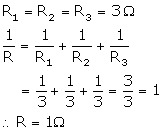
Question 5:
How should the two resistances of 2 ohms each be connencted so as to produce an equivalent resistance of 1 ohm ?
Solution :
Since the resultant resistance is less than the individual resistances, so the resistances should be connected in parallel.
Question 6:
Two resistances X and Y are connected turn by turn : (i) in parallel, and (ii) in series. In which case the resultant resistance will be less than either of the individual resistances ?
Solution :
In case of parallel combination, the resultant resistance will be less than either of the individual resistances.
Question 7:
What possible values of resultant resistance one can get by combining two resistances, one of value 2 ohm and the other 6 ohm ?
Solution :
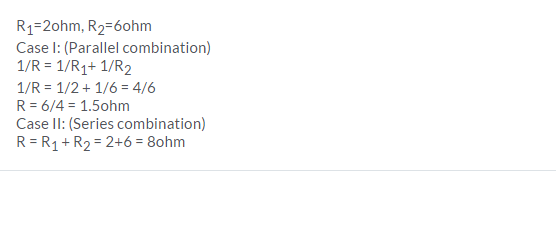
Lakhmir Singh Physics Class 10 Solutions
Page No:38
Question 8:
Show how you would connect two 4 ohm resistors to produce a combined resistance of
(a) 2 ohms
(b) 8 ohms.
Solution :
(a) By connecting in parallel: Since equivalent resistance will be
1/ R = 1/4 + 1/4 = 2/4 = 1/2
Therefore, R = 2 ohm
(b) By connecting in series : Since equivalent resistance will be
R = 4 ohm + 4 ohm = 8 ohm.
Question 9:
Which of the following resistor arrangement, A or B, has the lower combined resistance ?

Solution :
Resistance of arrangement A is 10 ohm.
Combined resistance of arrangement B is caculated as follows:
1/R = 1/10 + 1/1000 = (100+1)/1000
R = 1000/101 = 9.9 ohm
Therefore, arrangement B has lower combined resistance.
Question 10:
A wire that has resistance R is cut into two equal pieces. The two parts are joined in parallel. What is the resistance of the combination ?
Solution :
Resistance of each part is R/2.
Resultant resistance R’ is given by
1/R’ = 2/R+2/R
R’=R/4.
Question 11:
Calculate the combined resistance in each case :

Solution :
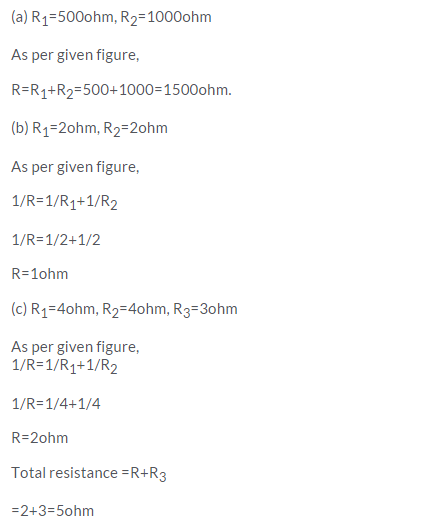
Question 12:
Find the current in each resistor in the circuit shown below :

Solution :

Question 13:
Explain with diagrams what is meant by the “series combination” and “parallel combination” of resistances. In which case the resultant resistance is : (i) less, and (ii) more, than either of the individual resistances ?
Solution :
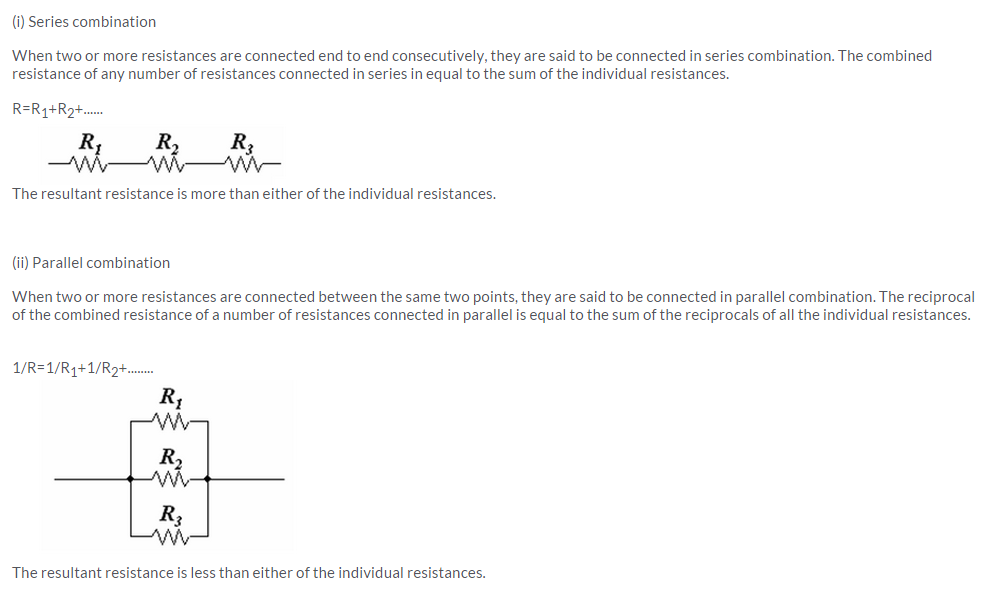
Question 14:
A battery of 9 V is connected in series with resistors of 0.2 Ω, 0.3 Ω, 0.4 Ω, 0.5 Ω and 12 Ω. How much current would flow through the 12 Ω resistor ?
Solution :

Question 15:
An electric bulb of resistance 20 Ω and a resistance wire of 4 Ω are connected in series with a 6 V battery. Draw the circuit diagram and calculate :
(a) total resistance of the circuit.
(b) current through the circuit.
(c) potential difference across the electric bulb.
(d) potential difference across the resistance wire.
Solution :
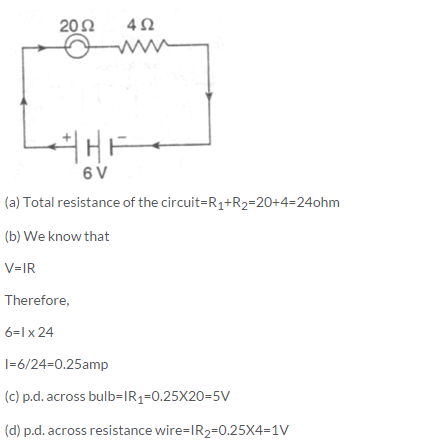
Question 16:
Three resistors are connected as shown in the diagram.

Through the resistor 5 ohm, a current of 1 ampere is flowing,
(i) What is the current through the other two resistors ?
(ii) What is the p.d. across AB and across AC ?
(iii) What is the total resistance ?
Solution :
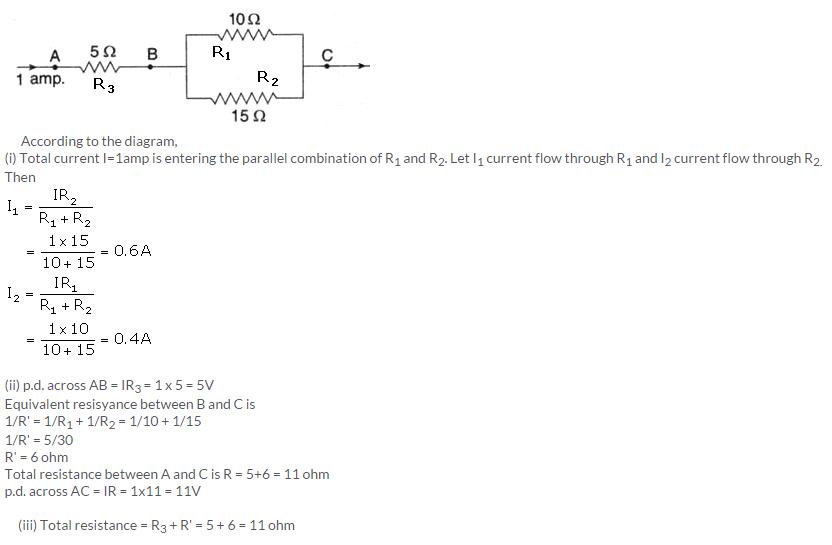
Question 17:
For the circuit shown in the diagram below :

What is the value of :
(i) current through 6 Ωresistor ?
(ii) potential difference across 12 Ω resistor ?
Solution :
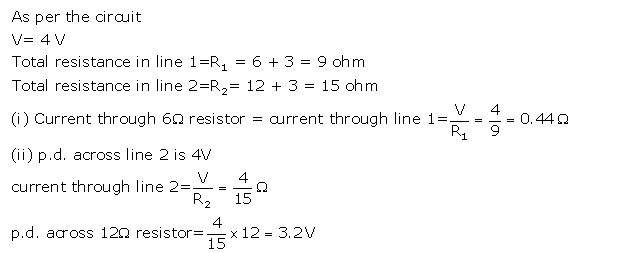
Lakhmir Singh Physics Class 10 Solutions Page No:39
Question 18:
Two resistors, with resistances 5 Ω and 10 Ω respectively are to be connected to a battery of emf 6 V so as to obtain :
(i) minimum current flowing (ii) maximum current flowing
(a) How will you connect the resistances in each case ? .
(b) Calculate the strength of the total current in the circuit in the two cases.
Solution :
Given: Two resistors with resistances R1=5ohm and R2=10ohm, V=6volt
(a) For minimum current these two should be connected in series. For maximum current these two should be connected in parallel.
(b)In series,
Total resistance = 5+10 = 15ohms
Therefore total current drawn = V/R = 6/15 = 0.4amps
In parallel,
Total resistance R is given as
1/R=1/R1+1/R2
1/R=1/5+1/10
1/R=3/10
R=10/3ohm
Therefore total current drawn by the circuit = V/R = 6/(10/3) =1.8amps.
Question 19:
The circuit diagram given below shows the combination of three resistors R
1
R
2
and R
3
:

Find : (i) total resistance of the circuit.
(ii) total current flowing in the circuit.
(iii) the potential difference across R
1
.
Solution :
(i) Total resistance of two resistors that are connected in parallel is
1/R’ = 1/3+1/6
1/R’ = 3/6
R’ = 2ohms
Total resistance of the circuit = 2+4ohms = 6ohms
(ii) Total current flowing through the circuit=V/total resistance
I = 12/6 = 2amps
(iii) Potential difference across R1=R1 x I = 4 x 2 = 8V.
Question 20:
In the circuit diagram given below, the current flowing across 5 ohm resistor is 1 amp. Find the current flowing through the other two resistors.

Solution :
Given :-
1 amp current is flowing through 5ohm resistor.
We know that in case of parallel connection, the p.d. across each resistor is same and is equal to the voltage applied.
Therefore, applied voltage, V = IR = 1 x 5 = 5V
So,
Current through 4 ohm resistor = V/R = 5/4 = 1.25 A
Current through 10 ohm resistor = V/R = 5/10 = 0.5 A
Get the list of all the important Physics Symbols that are used along with their name
Question 21:
A resistor has a resistance of 176 ohms. How many of these resistors should be connected in parallel so that their combination draws a current of 5 amperes from a 220 volt supply line ?
Solution :
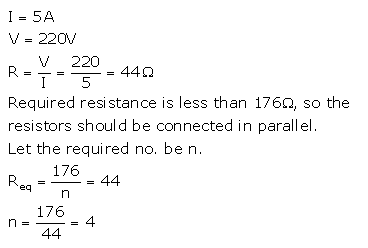
Question 22:
An electric heater which is connected to a 220 V supply line has two resistance coils A and B of 24 Ω resistance each. These coils can be used separately (one at a time), in series or in parallel. Calculate the current drawn when :
(a) only one coil A is used.
(b) coils A and B are used in series.
(c) coils A and B are used in parallel.
Solution :
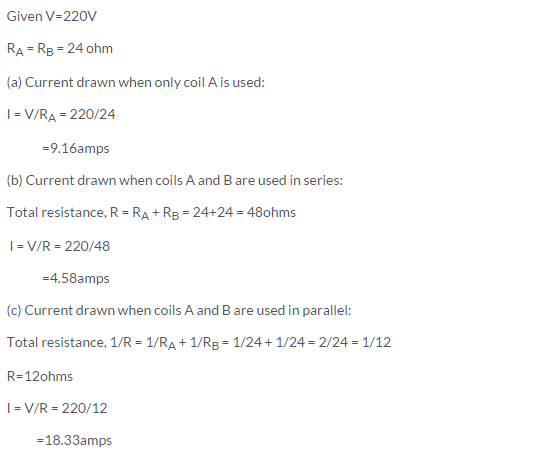
Question 23:
In the circuit diagram given below five resistances of 10 Ω, 40 Ω, 30 Ω, 20 Ω and 60 Ω are connected as shown to a 12 V battery.

Calculate :
(a) total resistance in the circuit.
(b) total current flowing in the circuit.
Solution :
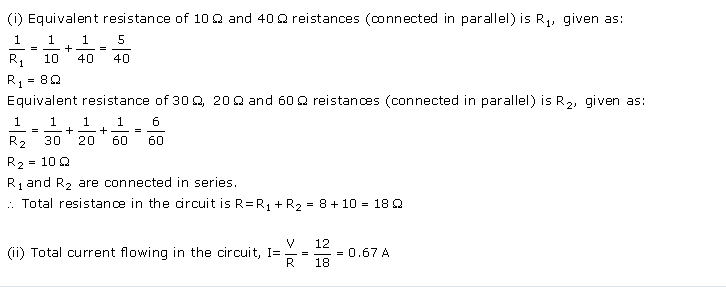
Lakhmir Singh Physics Class 10 Solutions Page No:40
Question 24:
In the circuit diagram given below, three resistors R
1,
R
2
, and R
3
of 5 Ω, 10 Ω and 30 Ω, respectively are connected as shown.

Calculate :
(a) current through each resistor.
(b) total current in the circuit.
(c) total resistance in the circuit.
Solution :
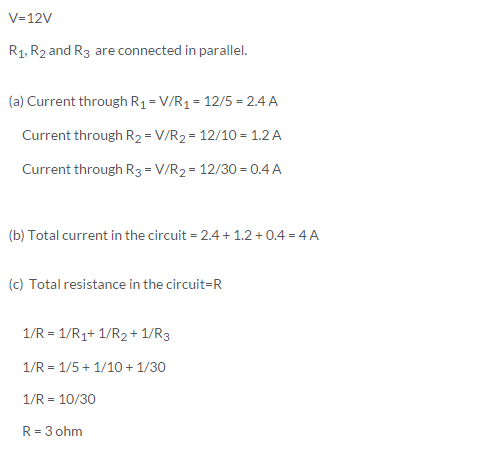
Question 25:
A p.d. of 4 V is applied to two resistors of 6 Ω and 2 Ω connected in series. Calculate :
(a) the combined resistance
(b) the current flowing
(c) the p.d. across the 6 Ω resistor
Solution :
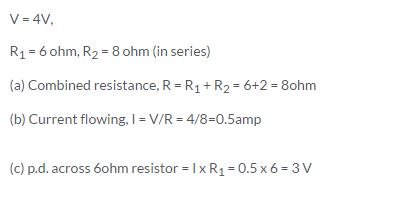
Question 26:
A p.d. of 6 V is applied to two resistors of 3 Ω and 6 Ω connected in parallel. Calculate :
(a) the combined resistance
(b) the current flowing in the main circuit
(c) the current flowing in the 3 Ω resistor.
Solution :
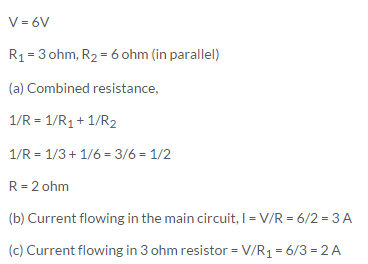
Question 27:
In the circuit shown below, the voltmeter reads 10 V.

(a) What is the combined resistance ?
(b) What current flows ?
(c) What is the p.d. across 2 Ω resistor ?
(d) What is the p.d. across 3 Ω resistor ?
Solution :
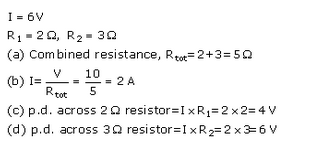
Question 28:
In the circuit given below :

(a) What is the combined resistance ?
(b) What is the p.d. across the combined resistance ?
(c) What is the p.d. across the 3 Ω resistor ?
(d) What is the current in the 3 Ω resistor ?
(e) What is the current in the 6 Ω resistor ?
Solution :
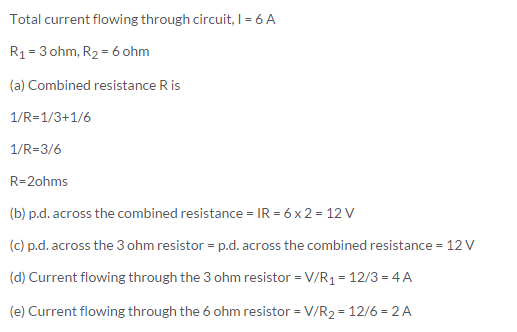
Lakhmir Singh Physics Class 10 Solutions Page No:41
Question 29:
A 5 V battery is connected to two 20 Ω resistors which are joined together in series.
(a) Draw a circuit diagram to represent this. Add an arrow to indicate the direction of conventional current flow in the circuit.
(b) What is the effective resistance of the two resistors ?
(c) Calculate the current that flows from the battery.
(d) What is the p.d. across each resistor ?
Solution :
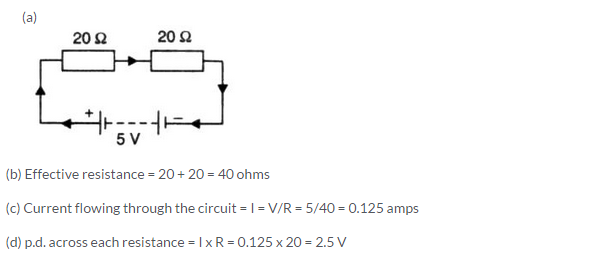
Question 30:
The figure given below shows an electric circuit in which current flows from a 6 V battery through two resistors.
(a) Are the resistors connected in series with each other or in parallel ?
(b) For each resistor, state the p.d. across it.
(c) The current flowing from the battery is shared between the two resistors. Which resistor will have bigger share of the current ?
(d) Calculate the effective resistance of the two resistors.
(e) Calculate the current that flows from the battery.

Solution :
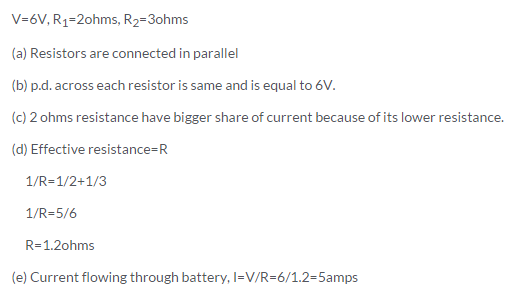
Question 31:
A 4 Ω coil and a 2 Ω coil are connected in parallel. What is their combined resistance ? A total current of 3 A passes through the coils. What current passes through the 2 Ω coil ?
Solution :
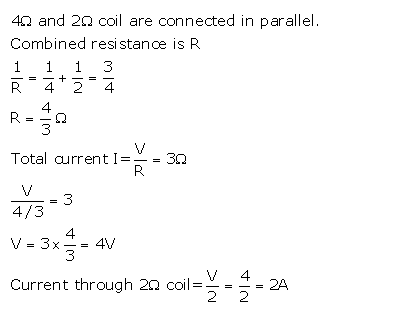
Question 32:
(a) With the help of a circuit diagram, deduce the equivalent resistance of two resistances connected in series.
(b) Two resistances are connected in series as shown in the diagram :

(i) What is the current through the 5 ohm resistance ?
(ii) What is the current through R ?
(iii) What is the value of R ?
(iv) What is the value of V ?
Solution :
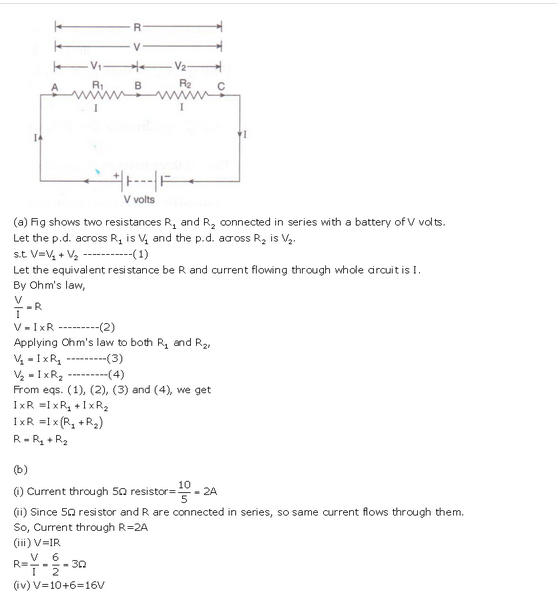
Question 33:
(a) With the help of a diagram, derive the formula for the resultant resistance of three resistors connected in series.
(b) For the circuit shown in the diagram given below :

Calculate :
(i) the value of current through each resistor.
(ii) the total current in the circuit.
(iii) the total effective resistance of the circuit.
Solution :
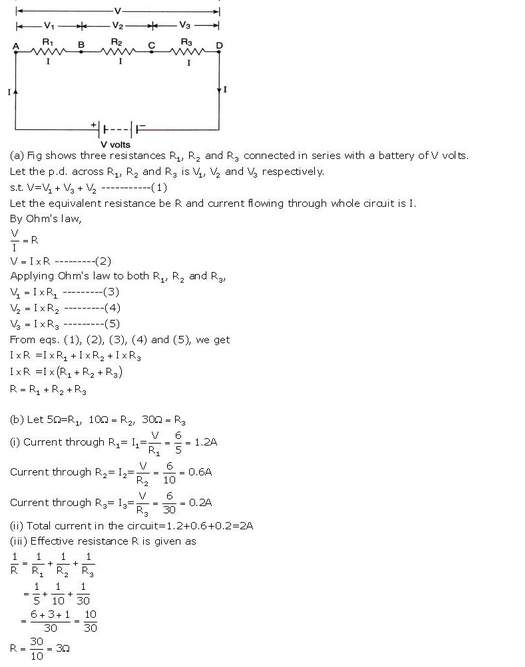
Lakhmir Singh Physics Class 10 Solutions Page No:42
Question 34:
(a) With the help of a circuit diagram, obtain the relation for the equivalent resistance of two resistances connected in parallel.
In the circuit diagram shown below, find :
(i) Total resistance.
(ii) Current shown by the ammeter A

Solution :
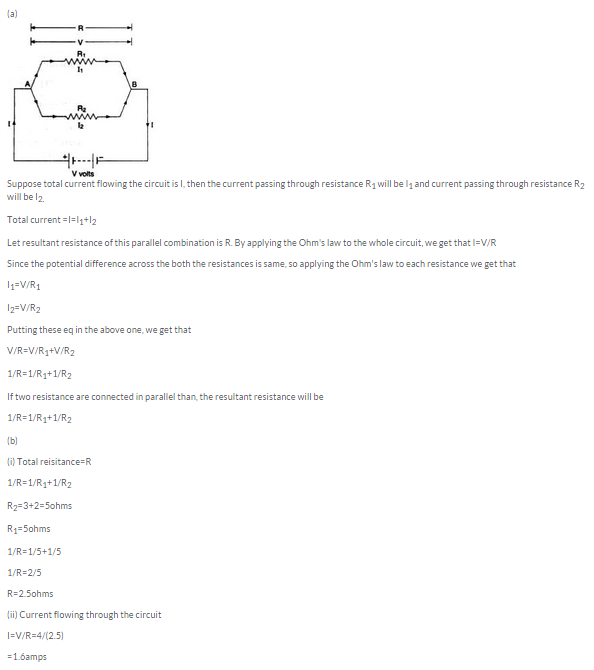
Question 35:
(a) Explain with the help of a labelled circuit diagram, how you will find the resistance of a combination of three resistors of resistances R
1
, R
2
and R
3
joined in parallel.
(b) In the diagram shown below, the cell and the ammeter both have negligible resistance. The resistors are identical.

With the switch K open, the ammeter reads 0.6 A. What will be the ammeter reading when the switch is closed ?
Solution :
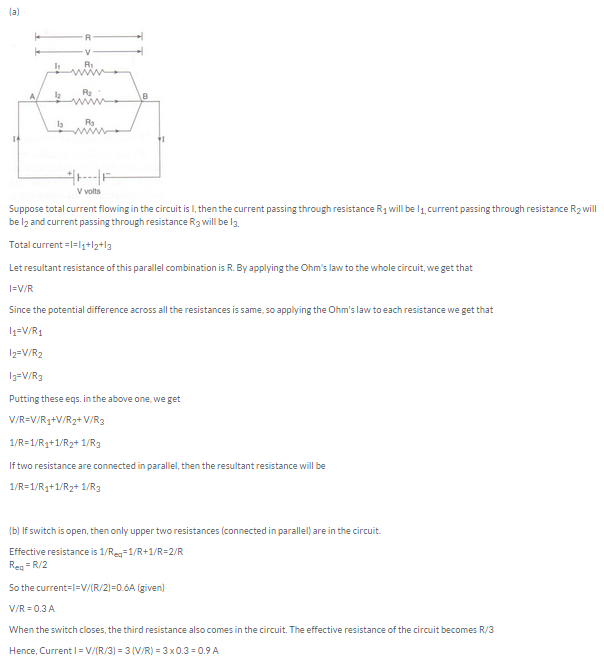
Lakhmir Singh Physics Class 10 Solutions Page No:43
Question 43:
Show with the help of diagrams, how you would connect three resistors each of resistance 6 Ω, so that the combination has resistance of (i) 9 Ω (ii) 4 Ω.
Solution :
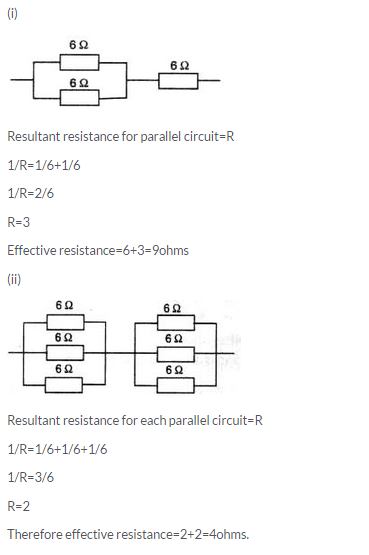
Question 44:
Two resistances when connected in parallel give resultant value of 2 ohm; when connected in series the value becomes 9 ohm. Calculate the value of each resistance.
Solution :
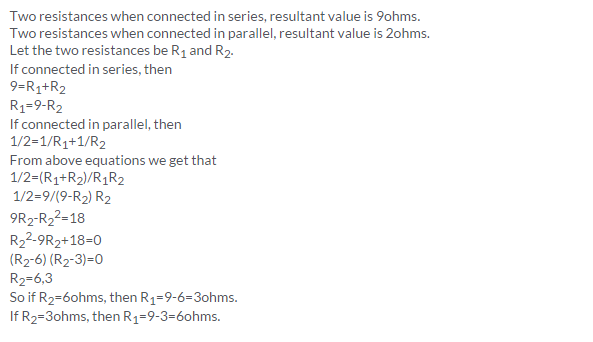
Question 45:
A resistor of 8 ohms is connected in parallel with another resistor X. The resultant resistance of the combination is 4.8 ohms. What is the value of the resistor X ?
Solution :
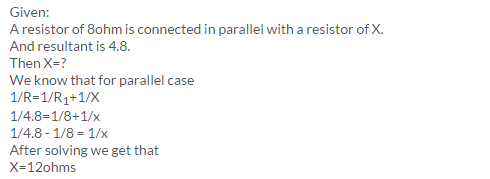
Question 46:
You are given three resistances of 1,2 and 3 ohms. Show by diagrams, how with the help of these resistances you can get:
(i) 6 Ω (ii) \(\frac{6}{11}\) Ω (iii) 1.5 Ω
Solution :
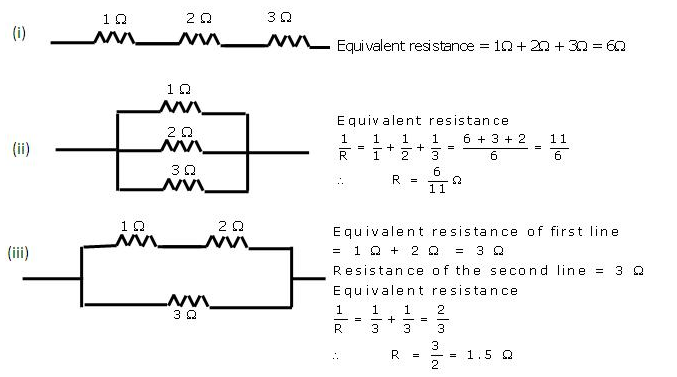
Lakhmir Singh Physics Class 10 Solutions Page No:44
Question 47:
How will you connect three resistors of 2 Ω, 3 Ω and 5 Ω respectively so as to obtain a resultant resistance of
2.5 Ω ? Draw the diagram to show the arrangement.
Solution :
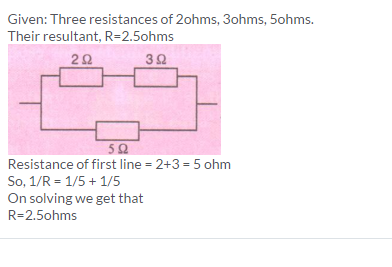
Question 48:
How will you connect three resistors of resistances 2 Ω, 3 Ω and 6Ω obtain a total n si stance of: (a) 4 Ω., and (b) 1Ω?
Solution :

Question 49:
What is (a) highest, and (b) lowest, resistance which can be obtained by combining Com resistors having the following resistances ?
4 Ω, 8 Ω, 12 Ω, 24 Ω
Solution :

Question 50:
What is the resistance between A and B in the figure given below ?

Solution :

Question 51:
You are given one hundred 1 Ω resister. What is the smallest and largest resistance you can make in a circuit using these ?
Solution :

Question 52:
You are supplied with a number of 100 Ω How could you combine some of these resisters to make a 250 Ω resistor ?
Solution :

Question 53:
The resistors R
1
, R
2
, R3 and R
4
in the figure given below are all equal in value.

What would you expect the voltmeters A, B and C to read assuming that the connecting wires in the circuit have negligible resistance ?
Solution :

Question 54:
Four resistances of 16 ohms each are connected in parallel. Four such combinations are connected in series.
What is the total resistance ?
Solution :

Question 55:
If the lamps are both the same in the figure given below and if A
1
, reads 0.50 A, what do A
2
, A
3
, A
4
and A
5
read ?

Solution :

Lakhmir Singh Physics Class 10 Solutions Page No:47
Question 1:
Are the lights in your house wired in series ?
Solution :
No, they are wired in parallel.
Question 2:
What happens to the other bulbs in a series circuit if one bulb blows off ?
Solution :
All the other bulbs also stop glowing.
Question 3:
What happens to the other bulbs in a parallel circuit if one bulb blows off ?
Solution :
All the other bulbs keep glowing.
Question 4:
Which type of circuit, series or parallel, is preferred while connecting a large number of bulbs :
(a) for decorating a hotel building from outside ?
(b) for lighting inside the rooms of the hotel ?
Solution :
(a) Series
(b) Parallel
Question 5:
Draw a circuit diagram to show how two 4 V electric lamps can be lit brightly from two 2 V cells.
Solution :
The two lamps (of 4V each) should be arranged in parallel with the two 2V cells.
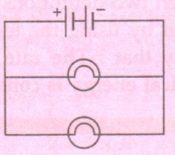
Question 6:
Why is a series arrangement not used for connecting domestic electrical appliances in a circuit ?
Solution :
A series arrangement is not used for connecting domestic electrical appliances in a circuit because if one electrical appliance stops working due to some defect, then all other appliance also stop working as the whole circuit is broken.
Question 7:
Give three reasons why different electrical appliances in a domestic circuit are connected in parallel.
Solution :
Different electrical appliances in a domestic circuit are connected in parallel because of the following advantages:
(i) If one electrical appliance stops working due to some defect, then all other appliances keep working properly.
(ii) Each electrical appliance has its own switch due to which it can be turned on or turned off independently, without affecting other appliances.
(iii) Each electrical appliance gets the same voltage as that of the power supply line.
Question 8:
Ten bulbs are connected in a series circuit to a power supply line. Ten identical bulbs are connected in a
(a) parallel circuit to an identical power supply line.
(b) Which circuit would have the highest voltage across each bulb ?
(c) In which circuit would the bulbs be brighter ?
(d) In which circuit, if one bulb blows out, all others will stop glowing ?
(e) Which circuit would have less current in it ?
Solution :
(a) Parallel circuit
(b) Parallel circuit
(c) Series circuit
(d) Series circuit.
Question 9:
Consider the circuits given below :

(a) In which circuit are the lamps dimmest ?
(b) In which circuit or circuits are the lamps of equal brightness to the lamps in circuit (/) ?
(c) Which circuit gives out the maximum light ?
Solution :
(a) circuit (ii)
(b) circuit (iii)
(c) circuit (iii)
Lakhmir Singh Physics Class 10 Solutions Page No:48
Question 10:
If you were going to connect two light bulbs to one battery, would you use a series or a parallel arrangement ? Why ? Which arrangement takes more current from the battery ?
Solution :
Parallel arrangement because if one electrical bulb stops glowing due to some defect the other will keep glowing.
Parallel arrangement takes more current from the battery due to its lesser equivalent resistance.
Question 11:
(a) Which is the better way to connect lights and other electrical appliances in domestic wiring : series circuits or parallel circuits ? Why ?
(b) Christmas tree lamps are usually wired in series. What happens if one lamp breaks ?
(c) An electrician has wired a house in such a way that if a lamp gets fused in one room of the house, all the lamps in other rooms of the house stop working. What is the defect in the wiring ?
(d) Draw a circuit diagram showing two electric lamps connected in parallel together with a cell and a switch that works both lamps. Mark an
![]() on your diagram to show where an ammeter should be placed to measure the current.
on your diagram to show where an ammeter should be placed to measure the current.
Solution :
(a) Parallel circuits – Because if one electrical appliance stops working due to some defect, then all other appliances in the circuit will keep working properly.
(b) All the other lamps stop glowing.
(c) All lamps are connected in series.
(d)
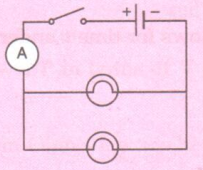
Question 14:
(a) Draw a circuit diagram showing two lamps, one cell and a switch connected in series.
(b) How can you change the brightness of the lamps ?
Solution :
(a)
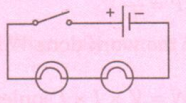
(b) The brightness of the lamps can be changed by connecting the lamps in parallel.
Question 15:
Consider the circuit given below where A, B and C are three identical light bulbs of constant resistance.

(a) List the bulbs in order of increasing brightness.
(b) If C burns out, what will be the brightness of A now compared with before ?
(c) If B burns out instead, what will be the brightness of A and C compared with before ?
Solution :
(a) C will be the brightest. Voltage will be distributed equally between A and B, so they will have equal brightness but lesser than that of C.
(b) A gets the same voltage as before, so its brightness remains the same.
(c) If B burns put, A will also stop glowing because it is connected in series with B. However, brightness of C remains the same.
Question 16:
How do you think the brightness of two lamps arranged in parallel compares with the brightness of two lamps arranged in series (both arrangements having one cell) ?
Solution :
The brightness of two lamps arranged in parallel is much more those arranged in series.
Question 17:
If current flows through two lamps arranged :
(a) in series,
(b) in parallel,
and the filament of one lamps breaks, what happens to the other lamp ? Explain your answer.
Solution :
(a) In case of series connection, if filament of one lamp breaks, the other wil stop glowing.
(b) In case of parallel connection, if filament of one lamp breaks, the other will keep glowing.
Lakhmir Singh Physics Class 10 Solutions Page No:49
Question 18:
The figure below shows a variable resistor in a dimmer switch.

How would you turn the switch to make the lights : (a) brighter, and (b) dimmer ? Explain your answer.
Solution :
(a) Turn the switch to right side so as the resistance decreases.
(b) Turn the switch to the left side so as the resistace increases.
Lakhmir Singh Physics Class 10 Solutions Page No:58
Question 1:
State two factors on which the electrical energy consumed by an electrical appliance depends.
Solution :
Electrical energy consumed by an electrical appliance depends on:
1. Power rating of the appliance.
2. Time for which the appliance is used.
Question 2:
Which one has a higher electrical resistance : a 100 watt bulb or a 60 watt bulb ?
Solution :
60 watt bulb, because power is inversely proportional to the resistance.
Question 3:
Name the commercial unit of electric energy.
Solution :
Kilowatt-hour is the commercial unit of electric energy.
Question 4:
An electric bulb is rated at 220 V, 100 W. What is its resistance ?
Solution :
V = 220 V, P = 100W
R=?
We know that
P = V2/R
Thus
R = V2/P = 2202/100 = 484ohm
Question 5:
What is the SI unit of (i) electric energy, and (ii) electric power ?
Solution :
(i) joule
(ii) watt
Question 6:
Name the quantity whose unit is (i) kilowatt, and (ii) kilowatt-hour.
Solution :
(i) Electric power
(ii) Electric energy
Question 7:
Which quantity has the unit of watt ?
Solution :
Electric power has the unit of watt.
Question 8:
What is the meaning of the symbol kWh ? Which quantity does it represent ?
Solution :
kWh is the short form of kilowatt-hour, which is the commercial unit of electrical energy.
Question 9:
If the potential difference between the end of a wire of fixed resistance is doubled, by how much does the electric power increase ?
Solution :
P=V2/R
R is fixed.
V becomes double.
Now, P = (2V)2/R = 4 V2/R
So, the electric power becomes four times its previous value.
Question 10:
An electric lamp is labelled 12 V, 36 W. This indicates that it should be used with a 12 V supply. What other information does the label provide ?
Solution :
Other information is that it will consume energy at the rate of 36 J/s.
Question 11:
What current will be taken by a 920 W appliance if the supply voltage is 230 V ?
Solution :
P=920W, V=230V, I=?
We know that
P = V x I,
920 = 230 x I
I = 920/230 = 4amp
Question 12:
Define watt. Write down an equation linking watts, volts and amperes.
Solution :
When an electrical appliance consumes electrical energy at the rate of 1 joule per second, its power is said to be 1 watt.
1 watt = 1 volt x 1 ampere.
Question 13:
Define watt-hour. How many joules are equal to 1 watt-hour ?
Solution :
One watt hour is the amount of electrical energy consumed when an electrical appliance of 1 watt power is used for 1 hour.
1 watt hour = 3600 joules
Question 14:
How much energy is consumed when a current of 5 amperes flows through the filament (or element) of a heater having resistance of 100 ohms for two hours ? Express it in joules.
Solution :
I=5amp, R=100ohms, t=2h
We know that
Electric energy consumed = P x t = I*I*Rt
= 25 x 100 x 2
= 5000 Wh
= 5 kwh
We know that 1kwh = 3.6 x 106 J
Therefore, 5kwh = 5 x 3.6 x 106 J = 18 x 106 J.
Question 15:
An electric bulb is connected to a 220 V power supply line. If the bulb draws a current of 0.5 A, calculate the power of the bulb.
Solution :
V=220V, I=0.5amp, P=?
We know that
P=VI=220X0.5
P=110 watt.
Question 16:
In which of the following cases more electrical energy is consumed per hour ?
(i) A current of 1 ampere passed through a resistance of 300 ohms.
(ii) A current of 2 amperes passed through a resistance of 100 ohms.
Solution :

Question 17:
An electric kettle rated at 220 V, 2.2 kW, works for 3 hours. Find the energy consumed and the current drawn.
Solution :
V=220V, P=2.2kW=2200W, t=3h
We know that
Electrical energy consumed = Pxt = 2.2×3 = 6.6 kWh
We have, P = V x I
2200 = 220 x I
I=10amp
Lakhmir Singh Physics Class 10 Solutions Page No:59
Question 18:
In a house two 60 W electric bulbs are lighted for 4 hours, and three 100 W bulbs for 5 hours everyday. Calculate the electric energy consumed in 30 days.
Solution :
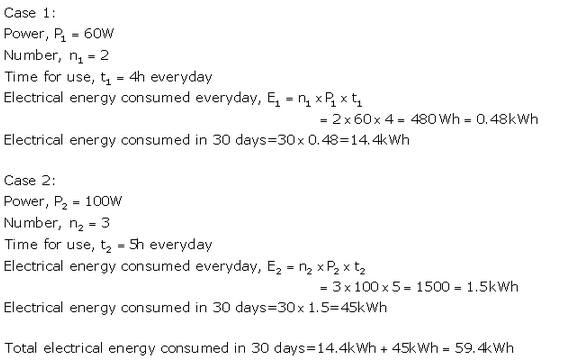
Question 19:
A bulb is rated as 250 V; 0.4 A. Find its : (i) power, and (ii) resistance.
Solution :
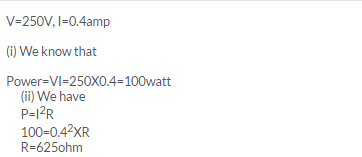
Question 20:
For a heater rated at 4 kW and 220 V, calculate :
(a) the current,
(b) the resistance of the heater,
(c) the energy consumed in 2 hours, and
(d) the cost if 1 kWh is priced at
₹
60.
Solution :
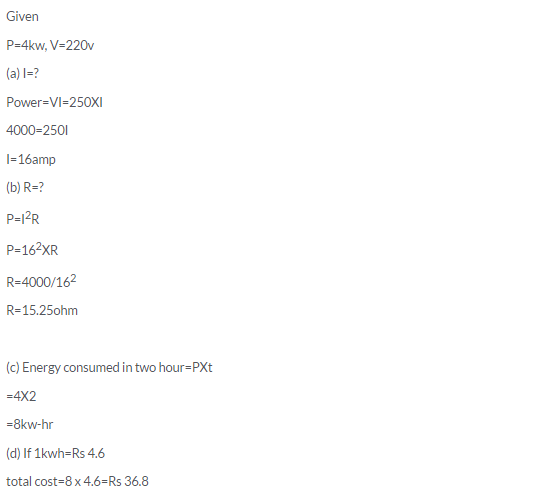
Question 21:
An electric motor takes 5 amperes current from a 220 volt supply line. Calculate the power of the motor and electrical energy consumed by it in 2
Solution :
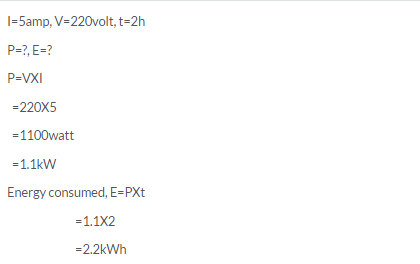
Question 22:
Which uses more energy : a 250 W TV set in 1 hour or a 1200 W toaster in 10 minutes ?
Solution :
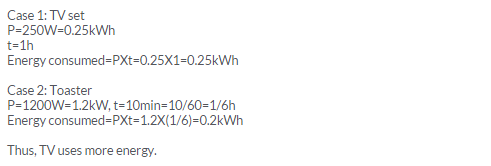
Question 23:
Calculate the power used in the 2 Ω resistor in each of the following circuits :
(i) a 6 V battery in series with 1 Ω and 2 Ω resistors.
(ii) a 4 V battery in parallel with 12 Ω and 2 Ω resistors.
Solution :
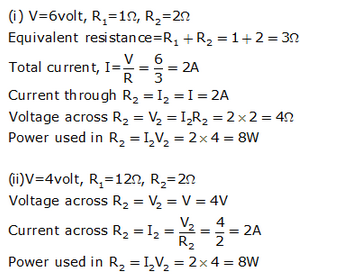
Question 24:
Two lamps, one rated 40 W at 220 V and the other 60 W at 220 V, are connected in parallel to the electric supply at 220 V.
(a) Draw a circuit diagram to show the connections.
(b) Calculate the current drawn from the electric supply.
(c) Calculate the total energy consumed by the two lamps together when they operate for one hour.
Solution :
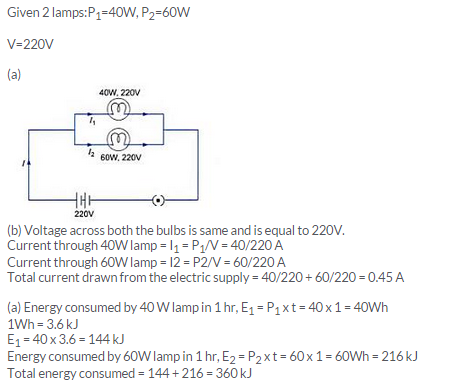
Question 25:
An electric kettle connected to the 230 V mains supply draws a current of 10 A. Calculate :
(a) the power of the kettle.
(b) the energy transferred in 1 minute.
Solution :
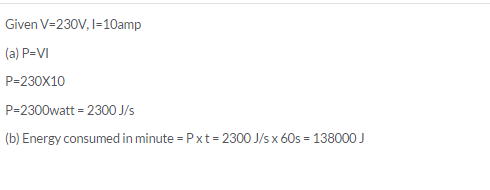
Question 26:
A 2 kW heater, a 200 W TV and three 100 W lamps are all switched on from 6m. to 10 p.m. What is the total cost at Rs. 5.50 per kWh ?
Solution :
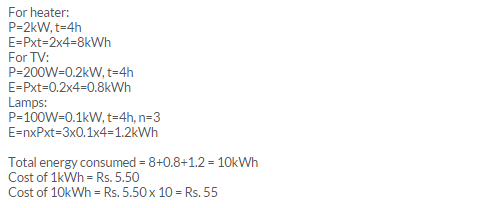
Question 27:
What is the maximum power in kilowatts of the appliance that can be connected safely to a 13 A ; 230 V mains socket ?
Solution :

Question 28:
An electric fan runs from the 230 V mains. The current flowing through it is 0.4 A. At what rate is electrical energy transferred by the fan ?
Solution :

Question 29:
(a) What is meant by “electric power” ? Write the formula for electric power in terms of potential difference and current.
(b) The diagram below shows a circuit containing a lamp L, a voltmeter and an ammeter. The voltmeter reading is 3 V and the ammeter reading is 0.5 A

(i) What is the resistance of the lamp ?
(ii) What is the power of the lamp ?
(c) Define kilowatt-hour. How many joules are there in one kilowatt-hour ?
(d) Calculate the cost of operating a heater of 500 W for 20 hours at the rate of ?
₹
3.90 per unit.
Solution :
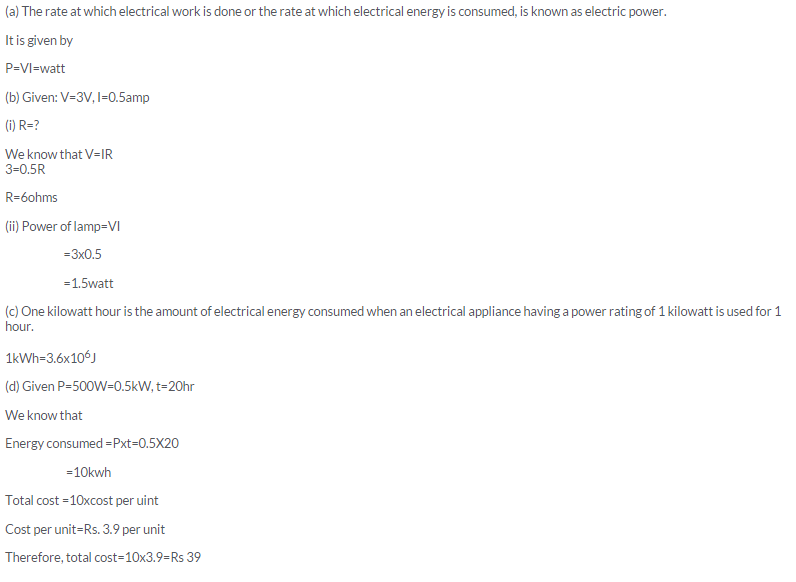
Lakhmir Singh Physics Class 10 Solutions Page No:60
Question 41:
State whether an electric heater will consume more electrical energy or less electrical energy per second when the length of its heating element is reduced. Give reasons for your answer.
Solution :
By reducing the length of element the resistance will decrease.
Power is inversely proportional to resistance. So, this will result in more consumption of energy.
Question 42:
The table below shows the current in three different electrical appliances when connected to the 240 V mains supply :

(a) Which appliance has the greatest electrical resistance ? How does the data show this ?
(b) The lamp is connected to the mains supply by using a thin, twin-cored cable consisting of live and neutral wires. State two reasons why this cable should not be used for connecting the kettle to the mains supply.
(c) Calculate the power rating of the kettle when it is operated from the 240 V mains supply.
(d) A man takes the kettle abroad where the mains supply is 120 V. What is the current in the kettle when it is operated from the 120 V supply ?
Solution :
(a) Lamp; because least current is flowing through it.
(b) Large current drawn by the kettle; Earth connection needed.
(c) We know that
P=VI
V=240V, I=8.5A
P=240X8.5=2040W=2.04kW
(d) When connected to 240 V supply, P=2040W
R = V2/P = 2402/240
R=28.23ohm
Now, when V=120V, R=28.23ohm
I=V/R=120/28.23=4.25A
Question 43:
A boy noted the readings on his home’s electricity meter on Sunday at 8 AM and again on Monday at 8 AM (see figure below).

(a) What was the meter reading on Sunday ?
(b) What was the meter reading on Monday ?
(c) How many units of electricity have been used ?
(d) In how much time these units have been used ?
(e) If the rate is Rs. 5 per unit, what is the cost of electricity used during this time ?
Solution :
(a) 42919
(b) 42935
(c) 42935-42919=16 units
(d) 24 hours
(e) Cost of 1 unit = Rs. 5
Cost of 16 units = 16×5 = Rs. 80
Question 44:
An electric bulb is rated as 10 W, 220 V. How many of these bulbs can be connected in parallel across the two wires of 220 V supply line if the maximum current which can be drawn is 5 A ?
Solution :
P=10W, V=220V, I=5A
We know that
P=VI
=220X5
P=1100W
Power of one bulb=10W
Total no. of bulbs that can be connected=1100/10=110
Question 45:
Two exactly similar electric lamps are arranged (i) in parallel, and (ii) in series. If the parallel and series combination of lamps are connected to 220 V supply line one by one, what will be the ratio of electric power consumed by them ?
Solution :
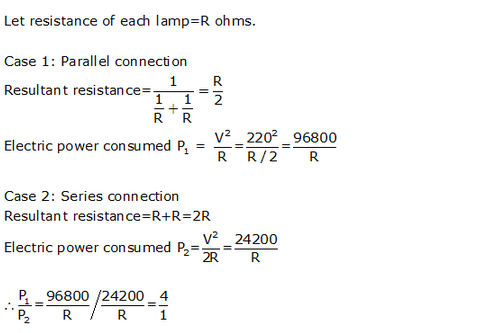
Lakhmir Singh Physics Class 10 Solutions Page No:66
Question 1:
How does the heat H produced by a current passing through a fixed resistance wire depend on the magnitude of current I ?
Solution :
Heat produced is directly proportional to the square of current.
Question 2:
If the current passing through a conductor is doubled, what will be the change in heat produced ?
Solution :
Heat produced is directly proportional to the square of current.
If current I is doubled, heat H will be four times.
Question 3:
Name two effects produced by electric current.
Solution :
Two effects of produced by electric current are:
(a) Heating effect
(b) Magnectic effect
Question 4:
Which effect of current is utilised in an electric light bulb ?
Solution :
Heating effect
Question 5:
Which effect of current is utilised in the working of an electric fuse ?
Solution :
Heating effect
Question 6:
Name two devices which work on the heating effect of electric current.
Solution :
Electirc heater and electric fuse.
Question 7:
Name two gases which are filled in filament type electric light bulbs.
Solution :
Argon and nitrogen.
Question 8:
Explain why, filament type electric bulbs are not power efficient.
Solution :
Filament type electric bulbs are not power efficien because most of the electric power consumed by the filament of a bulb appears as heat and only a small amount of electric power is converted into light.
Question 9:
Why does the connecting cord of an electric heater not glow hot while the heating element does ?
Solution :
The connecting cord of the heater made of copper does not glow because negligible heat is produced in it by passing current (because of its extremely low resistance); but the heating element made of nichrome glows because it becomes red-hot due to the large amount of heat produced on passing current (because of its high resistance).
Question 10:
(a) Write down the formula for the heat produced when a current I is passed through a resistor R for time
(b) An electric iron of resistance 20 ohms draws a current of 5 amperes. Calculate the heat produced in 30 seconds.
Solution :
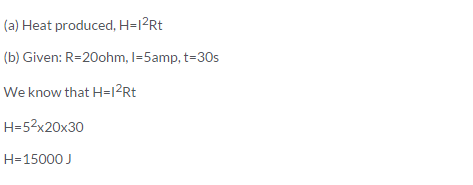
Question 11:
State three factors on which the heat produced by an electric current depends. How does it depend on these factors ?
Solution :
Heat produced by an electric current depends on the following factors:
(i) Heat produced is directly proportional to square of current.
(ii) Heat produced is directly proportional to resistance.
(iii) Heat produced is directly proportional to the time for which current flows.
Question 12:
(a) State and explain Joule’s law of heating.
(b) A resistance of 40 ohms and one of 60 ohms are arranged in series across 220 volt supply. Find the heat in joules produced by this combination of resistances in half a minute.
Solution :
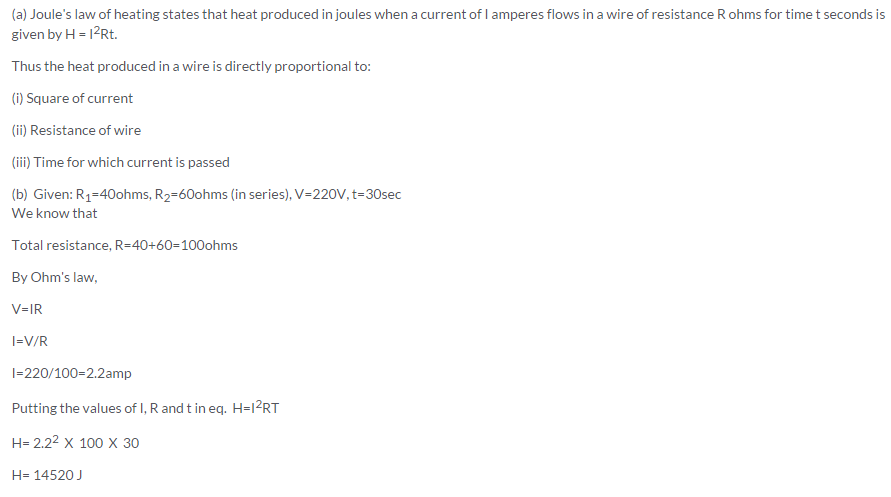
Question 13:
Why is an electric light bulb not filled with air ? Explain why argon or nitrogen is filled in an electric bulb.
Solution :
If air is filled in an electric bulb, then the extremely hot tungsten filament would burn up quickly in the oxygen of air. So, the electric bulb is filled with a chemically unreactive gas like argon or nitrogen. Thes gases do not react with the hot tungsten filament and hence prolong the life of the filament of the bulb.
Question 14:
Explain why, tungsten is used for making the filaments of electric bulbs.
Solution :
Tungsten is used for making the filaments of electric bulbs because it has a very high melting point. Due to its very high melting point, the tungsten filament can be kept white hot without melting away. Also, tungsten has high flexibility and low rate of evaporation at high temperature.
Question 15:
Explain why, the current that makes the heater element very hot, only slightly warms the connecting wires leading to the heater.
Solution :
The connecting wires of the heater get only slightly warm because they have extremely low resistance due to which negligible heat is produced in them by passing current.
Question 16:
When a current of 4.0 A passes through a certain resistor for 10 minutes, 2.88 x 10
4
J of heat are produced. Calculate :
(a) the power of the resistor.
(b) the voltage across the resistor.
Solution :
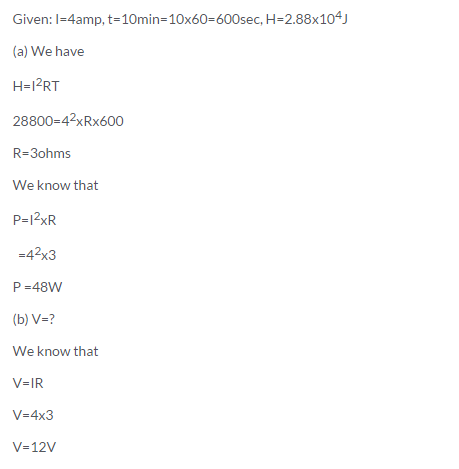
Question 17:
A heating coil has a resistance of 200 Ω. At what rate will heat be produced in it when a current of 2.5 A flows through it ?
Solution :

Question 18:
An electric heater of resistance 8Ω, takes a current of 15 A from the mains supply line. Calculate the rate at which heat is developed in the heater.
Solution :

Question 19:
A resistance of 25 Ω is connected to a 12 V battery. Calculate the heat energy in joules generated per minute.
Solution :
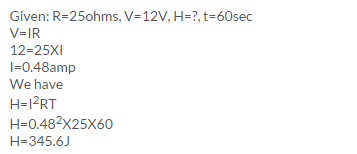
Question 20:
100 joules of heat is produced per second in a 4 ohm resistor. What is the potential difference across the resistor ?
Solution :
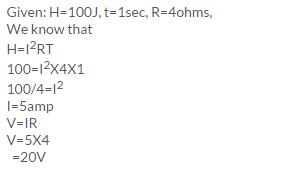
Question 21:
(a) Derive the expression for the heat produced due to a current ‘I’ flowing for a time interval ‘t’ through a resistor ‘R’ having a potential difference ‘V’ across its ends. With which name is this relation known ?
(b) How much heat will an instrument of 12 W produce in one minute if it is connected to a battery of 12 V ?
(c) The current passing through a room heater has been halved. What will happen to the heat produced by it ?
(d) What is meant by the heating effect of current ? Give two applications of the heating effect of current.
(e) Name the material which is used for making the filaments of an electric bulb.
Solution :
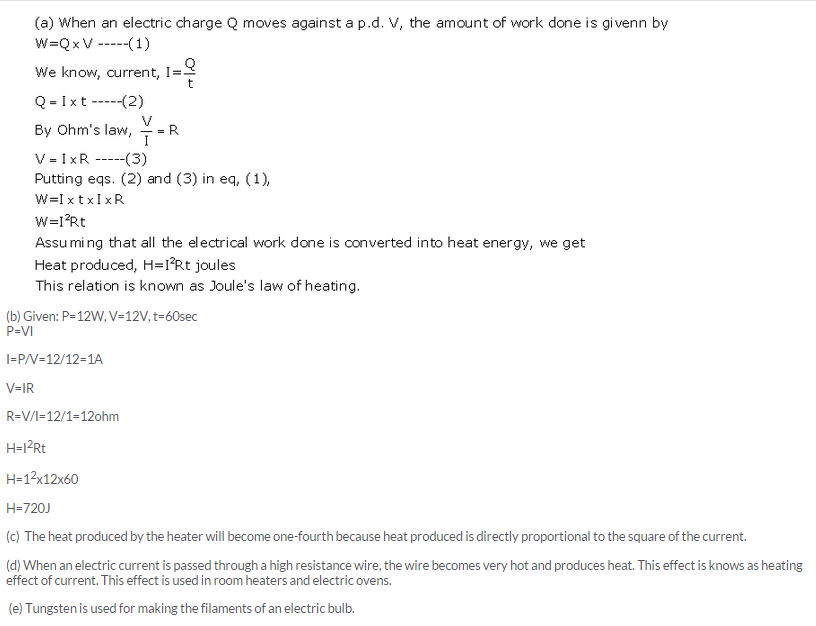
Lakhmir Singh Physics Class 10 Solutions Page No:67
Question 31:
The electrical resistivities of four materials P, Q, R and S are given below :

Which material will you use for making : (a) heating element of electric iron (b) connecting wires of electric iron (c) covering of connecting wires ? Give reason for your choice in each case.
Solution :
(a) S; because it has high resistivity of 11/10000000 ohm-m (it is actually nichrome).
(b) Q; because it has very low resistivity of 1.7/100000000 ohm-m (it is actually copper).
(c) R; because it has very very high resistivity of 1.0X100000000000000 ohm-m (it is actually rubber).
Question 32:
(a) How does the wire in the filament of a light bulb behave differently to the other wires in the circuit when the current flows ?
(b) What property of the filament wire accounts for this difference ?
Solution :
(a) The filament wire becomes white hot where as other wires in the circuit do not get heated much.
(b) High resistance of filament wire accounts for this difference.
Question 33:
Two exactly similar heating resistances are connected (i) in series, and (ii) in parallel, in two different circuits, one by one. If the same current is passed through both the combinations, is more heat obtained per minute when they are connected in series or when they are connected in parallel ? Give reason for your answer.
Solution :
In series, because total resistance in series connection is more than that in parallel connection.
Question 34:
An electric iron is connected to the mains power supply of 220 V. When the electric iron is adjusted at ‘minimum heating’ it consumes a power of 360 W but at ‘maximum heating’ it takes a power of 840 W. Calculate the current and resistance in each case.
Solution :
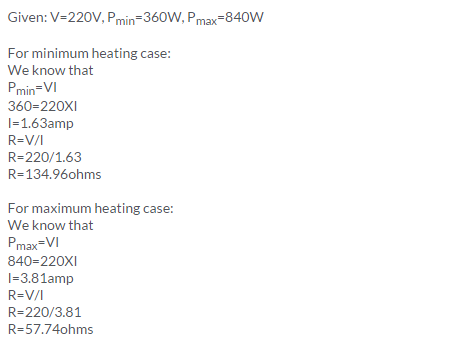
Question 35:
Which electric heating devices in your home do you think have resistors which control the flow of electricity ?
Solution :
Electric iron , electric oven, water heater, room heater.
You can watch video lessons on YouTube:
https://www.youtube.com/user/cbsepapers/videos
More Resources for CBSE Class 10:
Lakhmir Singh Class 10 Physics